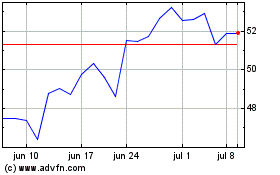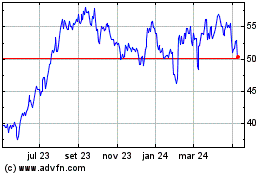CRC’s Carbon TerraVault Receives EPA Permits for CO2 Injection and Storage in California
31 Dezembro 2024 - 2:41PM

California Resources Corporation (NYSE: CRC) and its carbon
management business, Carbon TerraVault (CTV), today announced
receipt of final Class VI well permits from the Environmental
Protection Agency (EPA) for underground injection and storage of
carbon dioxide (CO2) into the 26R reservoir, located at CRC’s Elk
Hills Field in Kern County, California. The 26R reservoir is part
of CTV’s joint venture with Brookfield.
“We are proud to have received the state’s first
Class VI permits, enabling us to advance critical clean energy
projects in California,” said Francisco Leon, CRC’s President and
Chief Executive Officer. “This milestone underscores our leadership
in the carbon capture and storage sector and highlights our
capability to deliver carbon management solutions to key industrial
partners across the state.”
26R is one of two depleted oil and natural gas
reservoirs that comprise the CTV I storage site, with an expected
injection rate of 1.46 million metric tons of CO2 storage per
annum. Total estimated capacity of 26R is up to 38 million metric
tons.
About Carbon TerraVault
Carbon TerraVault (CTV), CRC’s carbon management
business, is developing services to capture, transport and
permanently store CO2 for its customers. CTV is engaged in a series
of proposed CCS projects that if developed will inject CO2 captured
from industrial sources into depleted reservoirs deep underground
for permanent sequestration. For more information, visit
carbonterravault.com.
About Carbon TerraVault Joint
Venture
Carbon TerraVault Joint Venture (CTV JV) is a
carbon management partnership focused on CCS development formed
between Carbon TerraVault I, LLC, a subsidiary of CRC, and
Brookfield, to develop both infrastructure and storage assets
required for CCS development in California. CRC owns 51% of CTV JV
with Brookfield owning the remaining 49% interest.
About California Resources
Corporation
California Resources Corporation (CRC) is an
independent energy and carbon management company committed to
energy transition. CRC is committed to environmental stewardship
while safely providing local, responsibly sourced energy. CRC is
also focused on maximizing the value of its land, mineral
ownership, and energy expertise for decarbonization by developing
CCS and other emissions reducing projects. For more information
about CRC, please visit www.crc.com.
Forward-Looking Statements
This document contains statements that CRC
believes to be “forward-looking statements” within the meaning of
Section 27A of the Securities Act of 1933 and Section 21E of the
Securities Exchange Act of 1934. All statements other than
historical facts are forward-looking statements, and include
statements regarding CRC's future financial position, business
strategy, projected revenues, earnings, costs, capital
expenditures and plans and objectives of management for the future.
Words such as “expect,” “could,” “may,” “anticipate,”
“intend,” “plan,” “ability,” “believe,” “seek,” “see,” “will,”
“would,” “estimate,” “forecast,” “target,” “guidance,” “outlook,”
“opportunity” or “strategy” or similar expressions are generally
intended to identify forward-looking statements. Such
forward-looking statements are subject to risks and uncertainties
that could cause actual results to differ materially from those
expressed in, or implied by, such statements.
Although CRC believes the expectations and
forecasts reflected in its forward-looking statements are
reasonable, they are inherently subject to numerous risks and
uncertainties, most of which are difficult to predict and many of
which are beyond its control. No assurance can be given that such
forward-looking statements will be correct or achieved or that the
assumptions are accurate or will not change over time. Particular
uncertainties that could cause CRC's actual results to be
materially different than those expressed in its forward-looking
statements include:
- fluctuations in commodity prices, including supply and demand
considerations for CRC's products and services, and the impact of
such fluctuations on revenues and operating expenses;
- decisions as to production levels and/or pricing by OPEC or
U.S. producers in future periods;
- government policy, war and political conditions and events,
including the military conflicts in Israel, Lebanon, Ukraine, Yemen
and the Red Sea;
- the ability to successfully execute integration efforts in
connection with CRC's merger with Aera Energy LLC, and achieve
projected synergies and ensure that such synergies are
sustainable;
- CRC’s ability to rely on the Class VI permits depends in part
on (i) the expiration of a 30-day waiting period during which
petitions concerning the permits may be submitted to the EPA and
the satisfactory resolution of any such petitions, (ii) completion
of construction of sequestration wells and surface facilities that
are consistent with permit requirements and are approved by the
EPA, and (iii) final authorization from the EPA to inject CO2;
- regulatory actions and changes that affect the oil and gas
industry generally and CRC in particular, including (1) the
availability or timing of, or conditions imposed on, EPA and other
governmental permits and approvals necessary for drilling or
development activities or its carbon management business; (2) the
management of energy, water, land, greenhouse gases (GHGs) or other
emissions, (3) the protection of health, safety and the
environment, or (4) the transportation, marketing and sale of CRC's
products;
- the efforts of activists to delay or prevent oil and gas
activities or the development of CRC's carbon management business
through a variety of tactics, including litigation;
- the impact of inflation on future expenses and changes
generally in the prices of goods and services;
- changes in business strategy and CRC's capital plan;
- lower-than-expected production or higher-than-expected
production decline rates;
- changes to CRC's estimates of reserves and related future cash
flows, including changes arising from its inability to develop such
reserves in a timely manner, and any inability to replace such
reserves;
- the recoverability of resources and unexpected geologic
conditions;
- general economic conditions and trends, including conditions in
the worldwide financial, trade and credit markets;
- production-sharing contracts' effects on production and
operating costs;
- the lack of available equipment, service or labor price
inflation;
- limitations on transportation or storage capacity and the need
to shut-in wells;
- any failure of risk management;
- results from operations and competition in the industries in
which CRC operates;
- CRC's ability to realize the anticipated benefits from prior or
future efforts to reduce costs;
- environmental risks and liability under federal, regional,
state, provincial, tribal, local and international environmental
laws and regulations (including remedial actions);
- the creditworthiness and performance of CRC's counterparties,
including financial institutions, operating partners, CCS project
participants and other parties;
- reorganization or restructuring of CRC's operations;
- CRC's ability to claim and utilize tax credits or other
incentives in connection with its CCS projects;
- CRC's ability to realize the benefits contemplated by its
energy transition strategies and initiatives, including CCS
projects and other renewable energy efforts;
- CRC's ability to successfully identify, develop and finance
carbon capture and storage projects and other renewable energy
efforts, including those in connection with the Carbon TerraVault
JV, and its ability to convert its CDMAs and MOUs to definitive
agreements and enter into other offtake agreements;
- CRC's ability to maximize the value of its carbon management
business and operate it on a stand alone basis;
- CRC's ability to successfully develop infrastructure projects
and enter into third party contracts on contemplated terms;
- uncertainty around the accounting of emissions and its ability
to successfully gather and verify emissions data and other
environmental impacts;
- changes to CRC's dividend policy and share repurchase program,
and its ability to declare future dividends or repurchase shares
under its debt agreements;
- limitations on CRC's financial flexibility due to existing and
future debt;
- insufficient cash flow to fund CRC's capital plan and other
planned investments and return capital to shareholders;
- changes in interest rates;
- CRC's access to and the terms of credit in commercial banking
and capital markets, including its ability to refinance its debt or
obtain separate financing for its carbon management business;
- changes in state, federal or international tax rates, including
CRC's ability to utilize its net operating loss carryforwards to
reduce its income tax obligations;
- effects of hedging transactions;
- the effect of CRC's stock price on costs associated with
incentive compensation;
- inability to enter into desirable transactions, including joint
ventures, divestitures of oil and natural gas properties and real
estate, and acquisitions, and CRC's ability to achieve any expected
synergies;
- disruptions due to earthquakes, forest fires, floods, extreme
weather events or other natural occurrences, accidents, mechanical
failures, power outages, transportation or storage constraints,
labor difficulties, cybersecurity breaches or attacks or other
catastrophic events;
- pandemics, epidemics, outbreaks, or other public health events,
such as the COVID-19 pandemic; and
- other factors discussed in Part I, Item 1A – Risk Factors in
CRC's Annual Report on Form 10-K and its other SEC filings
available at www.crc.com.
CRC cautions you not to place undue reliance on
forward-looking statements contained in this document, which speak
only as of the filing date, and it undertakes no obligation to
update this information. This document may also contain information
from third party sources. This data may involve a number of
assumptions and limitations, and CRC has not independently verified
them and does not warrant the accuracy or completeness of such
third-party information.
|
Contacts: |
|
Joanna Park (Investor Relations) 818-661-3731
Joanna.Park@crc.com |
Richard Venn (Media)818-661-6014Richard.Venn@crc.com |
|
|
This press release was published by a CLEAR® Verified
individual.
California Resources (NYSE:CRC)
Gráfico Histórico do Ativo
De Dez 2024 até Jan 2025

California Resources (NYSE:CRC)
Gráfico Histórico do Ativo
De Jan 2024 até Jan 2025
